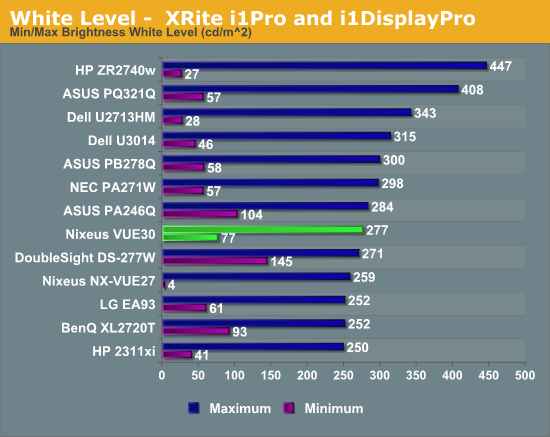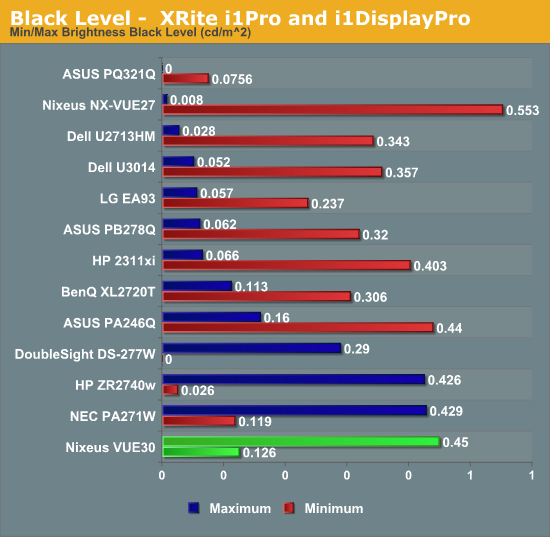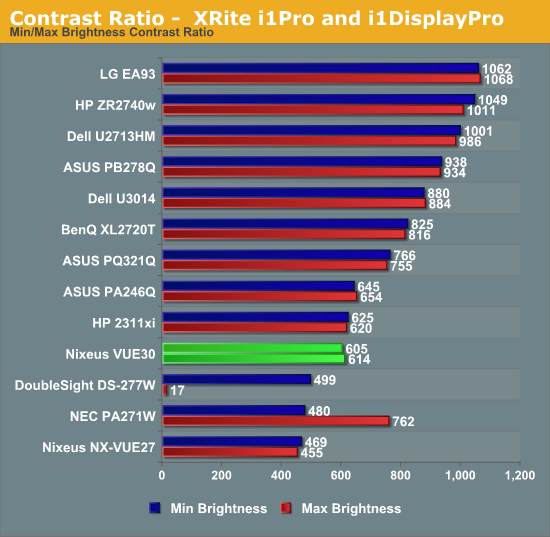Nixeus VUE 30: 30" 2560x1600 IPS Monitor Review
by Chris Heinonen on August 20, 2013 6:00 AM ESTIt seems that the larger the panel on a display I review, the brighter the display can get. I always expect the opposite, as lighting more screen would take more and more power. So far, that has not been the case. The VUE 30 is plenty bright, but not as blindingly bright as many other large displays. When I crank the brightness to maximum I measure 277 cd/m2 of brightness on a pure white screen. Moving the brightness to minimum drops this down to 77 cd/m2, which is below the 80 cd/m2 I like the minimum to fall under. This should provide plenty of range for most users.

With a black screen, we see a black level of 0.126 cd/m2 with the backlight at the minimum level. With the backlight to maximum this jumps up to 0.45 cd/m2. This level is very much in line with other computer monitors. I won’t fault Nixeus for this, but I’m always surprised at the level of black that is accepted with PC monitors that isn’t acceptable with TVs. Modern plasma displays can produce black levels of 0.006 cd/m2 under the same test conditions, and modern LCDs can hit 0.05 cd/m2 as well. I understand why plasma isn’t used for a PC display, but I’d like to see all vendors work on their black levels going forward. Basically, this panel seems similar to the 30" IPS displays we tested over five years ago; it's just half the price now.

These numbers provide us with a contrast ratio of just 610:1 on average. This falls well behind the Dell U3014 and ASUS PQ321Q displays, which are the most recently reviewed 30”+ displays I have data for. Those both cost a lot more, but being close to 600:1 is a disappointment to me.

With those basic measures out of the way, it was time to see how accurate the VUE 30 is.










95 Comments
View All Comments
Impulses - Tuesday, August 20, 2013 - link
Been hearing the same thing about OLED for years now... At this point I don't have any hope for it outside of small scale specialized usage cases (phones, electronic viewfinders on cameras, media players, mayyybe tablets).sonny73n - Tuesday, August 20, 2013 - link
Oh, please! Please make a 24 inch 2560x1600/1440 IPS monitor. Please, somebody, I'm begging you.DanNeely - Tuesday, August 20, 2013 - link
Don't hold your breath. That'd be ~125DPI; high enough that at anything beyond hunched over your laptop viewing distance windows controls are going to be squinty at native resolution; but not high enough to use a linear scaling mode. What you should be lusting after in that size bracket is a quadHD panel: ~180 DPI for software that supports it and relatively clean 2:1 scaling at 90dpi when it doesn't.ZeDestructor - Tuesday, August 20, 2013 - link
I run 1920x1200 on my 15.4" laptop without any scaling, and so do my friends on the even smaller 13.3" 1920x1080 ultrabooks.At 24", 2560x1600 is perfectly fine, but I'd rather skip straight to 3840x2400 myself....
seapeople - Saturday, August 24, 2013 - link
I speak for those of us with adequate vision insurance or other means by which we have used to correct our vision: Stop talking.geok1ng - Tuesday, August 20, 2013 - link
I think the review gave correct advice about this monitor: it is a cheap and valid alternative for those that want adobe RGB coverage. For gaming it is just about as bad as many other 30" and certainly not better for gaming than a 27" 2560x1440 LED panel. For productivity i believe the price is a bit off, since you are better served by a 39" 4k Seiki TV for the same price, with better colors at sRGB. These are the last remnants of a dieing breed of CCFL monitors.JarredWalton - Tuesday, August 20, 2013 - link
I've been gaming on a 30" HP LP3065 for something like six or seven years. I love it, and sadly I think the introduction of scalers to 30" displays simply made them more laggy. I'll be sad when I eventually have to replace this display!ZeDestructor - Tuesday, August 20, 2013 - link
Wait till the eDP panels show up. Then everyone and their dog will be doing bypasses to skip the electronics entirely and pipe DP signals straight into the eDP panel. For reference, people have done that to use iPad retina displays or test the newest batch of 13.3" IPS displays :Deric appla - Sunday, December 29, 2013 - link
I fully agree, I also have HP3065 and can't fault it for gaming and daily productive work, the only downside is power consumption.DParadoxx - Tuesday, August 20, 2013 - link
How could you not measure input lag at the native resolution? Nothing else matters.